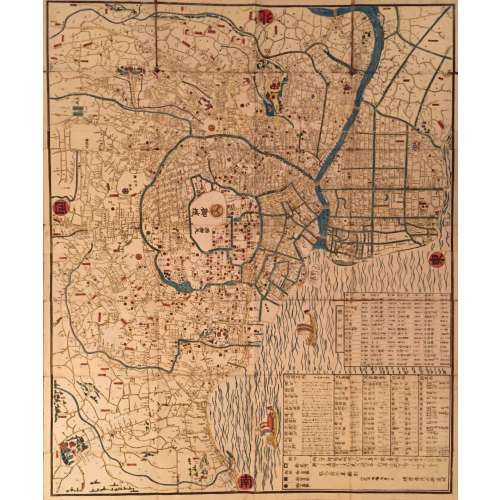-
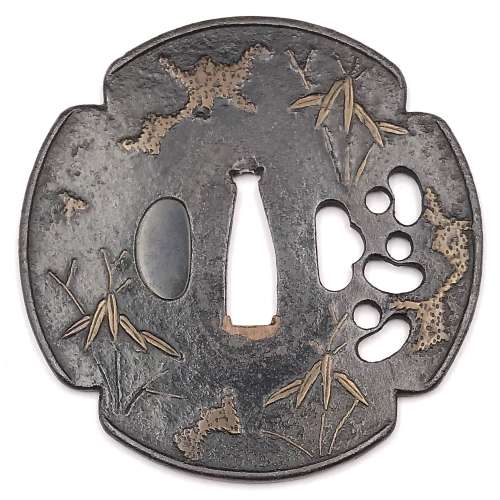 Iron tsuba of four-lobbed mokkō form (possibly it was circular and then altered to produce the mokkō) with slightly raised rim decorated with three kukurizaru ('tied up monkey' toy) in openwork (sukashi) next to kogai-hitsu-ana; inlaid in red-ish copper (suaka) with the design of bamboo stems and leaves, and shapeless masses which most probably represent snow. Kozuka-hitsu-ana plugged with shakudo. Probably original kogai-hitsu-ana. Copper sekigane. Surface still covered with lacquer (urushi). Late Muromachi period (1514-1573). Size: 86.1 x 85.8 x 2.6 mm NBTHK Certificate №4002543: Hozon - "Worthy of preservation" (Attribution: Mumei Heianjō Zōgan)
Iron tsuba of four-lobbed mokkō form (possibly it was circular and then altered to produce the mokkō) with slightly raised rim decorated with three kukurizaru ('tied up monkey' toy) in openwork (sukashi) next to kogai-hitsu-ana; inlaid in red-ish copper (suaka) with the design of bamboo stems and leaves, and shapeless masses which most probably represent snow. Kozuka-hitsu-ana plugged with shakudo. Probably original kogai-hitsu-ana. Copper sekigane. Surface still covered with lacquer (urushi). Late Muromachi period (1514-1573). Size: 86.1 x 85.8 x 2.6 mm NBTHK Certificate №4002543: Hozon - "Worthy of preservation" (Attribution: Mumei Heianjō Zōgan) -
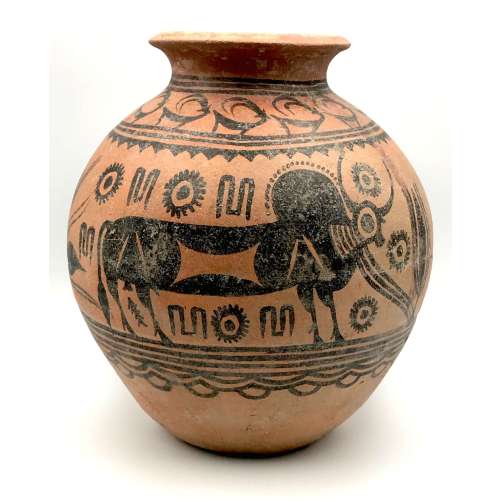 Circa 3300-2000 BC Dimensions: 184 x 165mm. Weight: 708grams
Circa 3300-2000 BC Dimensions: 184 x 165mm. Weight: 708grams -
 Ichikawa Ebizō III (Matsumoto Kōshirō II, Ichikawa Danjūrō IV, 1711-1778) probably shown as Shinozuka Gorō in the Shibaraku scene of the play Ōyoroi Ebidō Shinozuka, performed at the Nakamura Theater in the 11th month of 1772 (Meiwa 9). This was the occasion when he celebrated his name change, from Matsumoto Kōshirō II to Ichikawa Ebizō III. The lobster or giant shrimp (ebi) upon the Ichikawa family crest (three concentric squares - three measures of rice) on his garment underscores the fact of the name change (ebizō).
Ichikawa Ebizō III (Matsumoto Kōshirō II, Ichikawa Danjūrō IV, 1711-1778) probably shown as Shinozuka Gorō in the Shibaraku scene of the play Ōyoroi Ebidō Shinozuka, performed at the Nakamura Theater in the 11th month of 1772 (Meiwa 9). This was the occasion when he celebrated his name change, from Matsumoto Kōshirō II to Ichikawa Ebizō III. The lobster or giant shrimp (ebi) upon the Ichikawa family crest (three concentric squares - three measures of rice) on his garment underscores the fact of the name change (ebizō). -
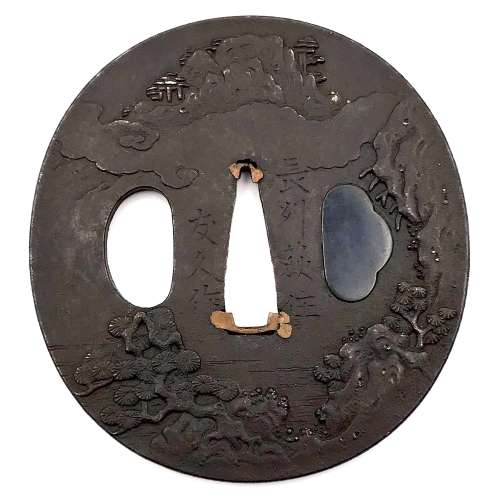
Iron tsuba of oval form carved with a landscape motif. Kogai-hitsu-ana plugged with shakudo. Sekigane of copper.
Signed: Chōshū Hagi-jū Tomohisa saku (長州萩住友久作).
Tomohisa, adopted son of Rokurō'emon, was 3rd generation master of Kawaji School from Hagi in Nagato (Chōshū), lived 1687-1743 [M. Sesko 'Genealogies', page 117].
Edo period, circa 1700. Dimensions: 71.1 x 66.8 x 2.9 mm For his adopted son Hisatsugu work see TSU-0103 in this collection. -
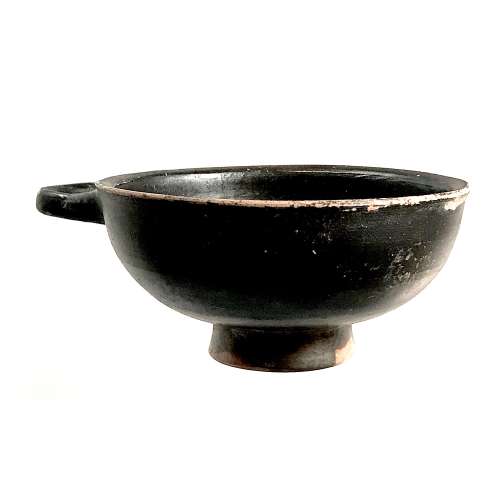 Ancient Greek glazed terracotta kylix (cup with a shallow bowl and a stem), ca. 350 BC. Dimensions: 14.4 x 11 cm The primary use for the kylix was drinking wine (usually mixed with water, and sometimes other flavourings) at a symposium or male "drinking party" in the ancient Greek world, so they are often decorated with scenes of a humorous, light-hearted, or sexual nature that would only become visible when the cup was drained.
Ancient Greek glazed terracotta kylix (cup with a shallow bowl and a stem), ca. 350 BC. Dimensions: 14.4 x 11 cm The primary use for the kylix was drinking wine (usually mixed with water, and sometimes other flavourings) at a symposium or male "drinking party" in the ancient Greek world, so they are often decorated with scenes of a humorous, light-hearted, or sexual nature that would only become visible when the cup was drained. -
 This print was sold to me with the following description: "Ikkansai EISHO (Fl. early 19th c.). A portrait of the wrestler Kuroyanagi Matsujiro, ring name Kumagatake Inosuke. Eisho was a pupil of Eishi. Published c. 1820s by Uoya Eikichi. Signed Shunsai Eisho ga." As a result of our joint effort with my beloved sister, we have so far found the following: The artis is mentioned in The Hotei Encyclopedia of Japanese Woodblock Prints, 2005, Vol 2; p. 438 under the name of Harukawa Eichō. From this source we learned that the artist was active from about 1818 till 1844, and was a print designer in Kyoto. He was a student first of Harukawa Goshichi and later studied in Edo (Tokyo) with Keisai Eisen, when he assumed the art name 'Eichō'. Other names: Shunsai. The Japanese web page dedicated to Harukawa Eichō provides more details: The artist lived from the 4th year of Tenmei ( 1784 ) to the first year of Kaei ( 1848 ). He was a student of Harukawa Goshichi, Kikukawa Eizan as well as of Keisai Eisen. His popular name was Kamenosuke. He was from Kyoto. He took "gagō" (artistic names) of Eishō when he was a student of Harukawa Goshichi; later, when he became a student of Kikukawa Eizan and Keisai Eisen he took the name of Kikukawa Eichō. The artist was mostly known for his bijinga (beautiful women) prints as well as kanazōshi illustrations. Nothing is said anywhere about his sumo prints, though the reference to another Kyushu sumo wrestler portrait has been found. The sumo wrestler Kuroyanagi Matsujiro is also a somewhat obscure figure: information about his life and career is quite inconsistent. It may so happened that two different persons were combined together. Wikipedia page about Aoi Aso Jinja, a Shinto shrine in Hitoyoshi in Kumamoto prefecture, tells us the following:This information has some inconsistencies already. If our hero was born in 1807 and promoted to ōzeki at the age of 32, it should have been the year 1839, not 1847. I found Kumagatake Isuke at "Sumo Reference" website:
This print was sold to me with the following description: "Ikkansai EISHO (Fl. early 19th c.). A portrait of the wrestler Kuroyanagi Matsujiro, ring name Kumagatake Inosuke. Eisho was a pupil of Eishi. Published c. 1820s by Uoya Eikichi. Signed Shunsai Eisho ga." As a result of our joint effort with my beloved sister, we have so far found the following: The artis is mentioned in The Hotei Encyclopedia of Japanese Woodblock Prints, 2005, Vol 2; p. 438 under the name of Harukawa Eichō. From this source we learned that the artist was active from about 1818 till 1844, and was a print designer in Kyoto. He was a student first of Harukawa Goshichi and later studied in Edo (Tokyo) with Keisai Eisen, when he assumed the art name 'Eichō'. Other names: Shunsai. The Japanese web page dedicated to Harukawa Eichō provides more details: The artist lived from the 4th year of Tenmei ( 1784 ) to the first year of Kaei ( 1848 ). He was a student of Harukawa Goshichi, Kikukawa Eizan as well as of Keisai Eisen. His popular name was Kamenosuke. He was from Kyoto. He took "gagō" (artistic names) of Eishō when he was a student of Harukawa Goshichi; later, when he became a student of Kikukawa Eizan and Keisai Eisen he took the name of Kikukawa Eichō. The artist was mostly known for his bijinga (beautiful women) prints as well as kanazōshi illustrations. Nothing is said anywhere about his sumo prints, though the reference to another Kyushu sumo wrestler portrait has been found. The sumo wrestler Kuroyanagi Matsujiro is also a somewhat obscure figure: information about his life and career is quite inconsistent. It may so happened that two different persons were combined together. Wikipedia page about Aoi Aso Jinja, a Shinto shrine in Hitoyoshi in Kumamoto prefecture, tells us the following:This information has some inconsistencies already. If our hero was born in 1807 and promoted to ōzeki at the age of 32, it should have been the year 1839, not 1847. I found Kumagatake Isuke at "Sumo Reference" website:Kuroki Matsujiro (黒木松次郎) was born in the village of Itsuki in Kuma district, Kumamoto prefecture, island of Kyushu in Bunka era, 4th year (1807). Since from his childhood he was blessed by great physique and tough strength. He had affection for sumo. At the age of 18 he became a sumo student of Kumamoto Shimakawa Ikuhei and took the name of Toyama Hidekichi (遠山日出吉). At the age of 23 (1830), he entered sumo stables in Kyoto, mastered the art of taming of young horses, and his talents improved. At the age of 31 he went to Edo, and became a disciple of the ōzeki Oitekaze Kitaro of Hirado domain in Hizen province, also from Kyushu island. After that, he changed his name and became Kuroyanagi Matsujiro (黒柳松次郎 – as on the print). In 1847 (Bunka era, 4th year) he distinguished himself by advancing to the first grade, and at the age of 32 he was promoted to ozeki level, becoming sekitori. After changing his name to Kuma-ga-take Inosuke (熊ヶ嶽猪之介 / くまがたけいのすけ) he displayed further efforts, and became one of the strongmen that fermented sumo wrestling in Edo. In 1853 (Kaei era, 6th year) he retired and returned to his village, becoming an employee as a strongman of Sagara domain (相良藩), and worked hard as instructor of the sumo training hall to train successors until 1855 (Ansei era, 2nd year) when he passed away at the age of 48. Even today Kuma-ga-take's home exists in Itsukimura (his native village). Also, on those grounds a descendant of Kuma-ga-take runs minshuku (guest house) that bears the name of "The Kuroki Pension (lodging) ", and tourists come to visit from various parts of Japan. In 2015, tenth month, within the borders of Aoi Aso Shrine there was built a gravestone publicly honoring Kuma-ga-take Inosuke, sumo wrestler from Edo / of Edo period.
The real name is the same, the ring name Kuroyanagi Matsujiro is the same, however, the date of birth here is 1815. He fought from 1836 till 1853 - which is quite similar to "At the age of 31 he went to Edo, and became a disciple of the ōzeki Oitekaze Kitaro". Though, in 1836 he might be 29 years old. His bouts are listed from spring 1841 to spring 1848 under the name of Kuroyanagi and from winter 1848 till spring 1853 he listed under the name of Kumagatake Isuke [Inosuke].Highest Rank Maegashira 4 Real Name Kuroki Birth Date 1815 Shusshin Kumamoto-ken, Kuma-gun Death Date March 6, 1855 (40 years) Heya Oitekaze Shikona Kuroyanagi Matsujiro - Kumagatake Isuke Hatsu Dohyo 1836.02 (Sandanme) Intai 1853.02 On another important sumo history website, I found that Kuroyanagi first appeared at ring in the spring of 1823 (he might have been 16 years old then, which does not seem right). Then, in the winter tournament of 1848 Kuroyanagi took the name Kumagatake. At the spring tournament of 1853 Kumagatake (Kuroyanagi) retired. This is quite consistent so far.
Then, I found Oitekaze Kitaro, allegedly the teacher of Kuroyanagi.
Everything look good with an exception of ring names (shikona): Kuroyanagi Matsujiro (1823-1828) - Kuroyanagi Sumiemon (1829-30) - Oitekaze Kitaro (1831-1839). May it be that Sato Matsutaro fought under the name of Kuroyanagi Matsujiro until Kuroki Matsujiro took this name from his master? I don't have another explanation of the enigma. What we know is that we have a portrait of a sumo wrestler called Kuroyanagi Matsujiro from Kyushu, but we don't know whether this was the one from Kumamoto (Kumagatake Inosuke, 1807/1815-1855) or the other from Kanagawa (Oitekaze Kitaro, 1799-1865). Subsequently, we may declare that the artist is Shunsai Eishō, a.k.a.Harukawa Eichō from Eishi school (The Hotei Encyclodepdia, p. 524), we can date the print from 1818 to 1844, and only tell that the wrestler is Kuroyanagi Matsujiro from Kyushu (either Kumagatake Inosuke or Oitekaze Kitaro). The publisher of the print is Moriya Jihei (Marks №353, p. 243-5). That's it.Highest Rank Ozeki Real Name SATO Matsujiro (Matsutaro#) Birth Date 1799 Shusshin Kanagawa-ken, Tsukui-gun Death Date May 4, 1865 (66 years) Heya Oitekaze Shikona Kuroyanagi Matsujiro - Kuroyanagi Sumiemon - Oitekaze Kitaro Hatsu Dohyo 1817.10 (Jonokuchi) Intai 1839.03 -
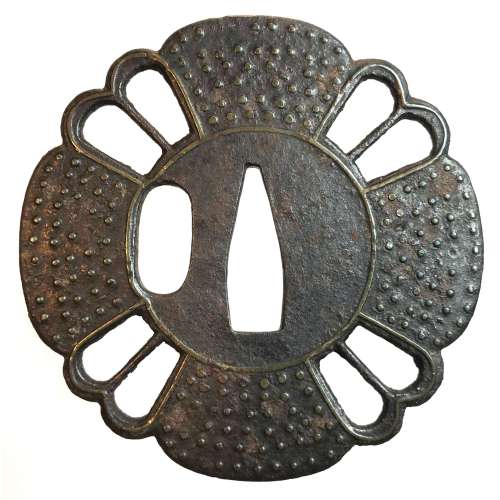 An iron tsuba of 12-lobed form with alternating four solid and four openwork areas, each with a central bar. Symbolism remains unclear, possibly - a gunbai, i.e. military leader's fan. The solid parts decorated with 5 to 6 rows of brass dots of nail heads inlaid in ten-zōgan. The center of the plate as well as the sukashi elements are outlined with brass wire. The kozuka-hitsu-ana seems original. Muromachi period. Dimensions: 77.9 x 77.5 x 3.2 mm.
An iron tsuba of 12-lobed form with alternating four solid and four openwork areas, each with a central bar. Symbolism remains unclear, possibly - a gunbai, i.e. military leader's fan. The solid parts decorated with 5 to 6 rows of brass dots of nail heads inlaid in ten-zōgan. The center of the plate as well as the sukashi elements are outlined with brass wire. The kozuka-hitsu-ana seems original. Muromachi period. Dimensions: 77.9 x 77.5 x 3.2 mm. -
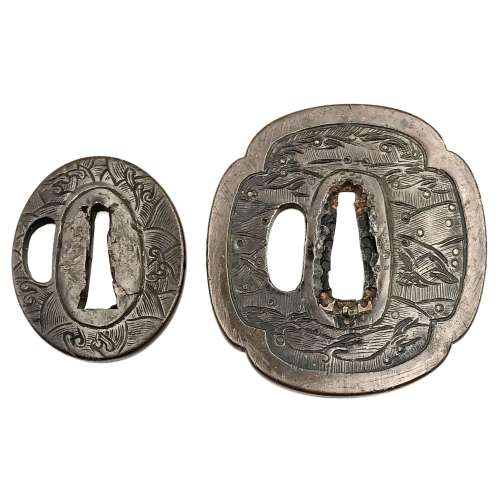 Two ymagane tsuba (daisho) with chiseled diaper pattern of waves. The larger tsuba (dai) is of mokkō form with a wide (4.6 mm) polished rim (fukurin?). Water spray is realized in copper ten-zōgan. Size: 75.0 x 71.6 x 3.2 (center), 4.0 (rim) mm. Copper sekigane. The smaller tsuba (sho) is of oval form, without a rim. No inlay. Size: 53.2 x 45.5 x 4.1 mm. Ko-kinko school. Muromachi period. In Kokusai Tosogu Kai; 5th International Convention & Exhibition, 2009 on page 51 under № 5-U8 there is a piece from George Gaucys collection, described as follows: Unsigned Tachi-Kanagushi tsuba, Yamagane base. Nami (wave) motif. Circa: Muromachi period (15th century). 6.88 x 6.81 x 0.45 (rim), 0.36 (center). The classic wave form is typically seen in Muromachi period tosogu. The patina is rich and rustic, which presents history and warmth. This tsuba may be interpreted as either tachi-kanagushi or ko-kinko work. Early tachi tsuba were symmetrical in design and also not very sophisticated, Design elements filled in up to seppadai as the waves do in this tsuba. There is a simple fikurin of the same metal and it is flat to the plate. On the ko-kinko side, the crests of the waves show more complexity than tachi works and less symmetry. A very intriguing tsuba from late Muromachi period."
Two ymagane tsuba (daisho) with chiseled diaper pattern of waves. The larger tsuba (dai) is of mokkō form with a wide (4.6 mm) polished rim (fukurin?). Water spray is realized in copper ten-zōgan. Size: 75.0 x 71.6 x 3.2 (center), 4.0 (rim) mm. Copper sekigane. The smaller tsuba (sho) is of oval form, without a rim. No inlay. Size: 53.2 x 45.5 x 4.1 mm. Ko-kinko school. Muromachi period. In Kokusai Tosogu Kai; 5th International Convention & Exhibition, 2009 on page 51 under № 5-U8 there is a piece from George Gaucys collection, described as follows: Unsigned Tachi-Kanagushi tsuba, Yamagane base. Nami (wave) motif. Circa: Muromachi period (15th century). 6.88 x 6.81 x 0.45 (rim), 0.36 (center). The classic wave form is typically seen in Muromachi period tosogu. The patina is rich and rustic, which presents history and warmth. This tsuba may be interpreted as either tachi-kanagushi or ko-kinko work. Early tachi tsuba were symmetrical in design and also not very sophisticated, Design elements filled in up to seppadai as the waves do in this tsuba. There is a simple fikurin of the same metal and it is flat to the plate. On the ko-kinko side, the crests of the waves show more complexity than tachi works and less symmetry. A very intriguing tsuba from late Muromachi period."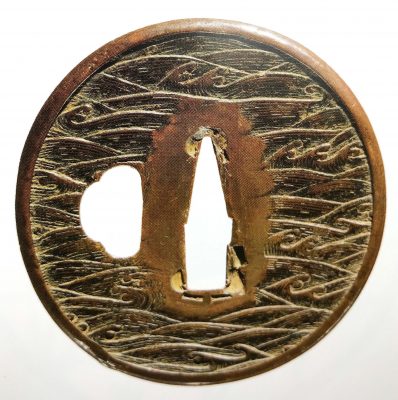
Kokusai Tosogu Kai 5th, 2009, p. 51, № 5-U8: ko-kinko or tachi-kanagushi tsuba.
-
 A circular iron tsuba with a design of three monkey toys (kukurizaru) in small openwork (ko-sukashi); the plate further decorated with four rows of brass dot inlay (ten-zogan). The center of the plate and the openings are outlined with brass wire. Copper sekigane. A few dots missing. Muromachi period. Dimensions: 89.0 x 88.2 x 2.9 mm. Kukurizaru was an often used motif on old tsuba. The symbol has two explanations: (1) "upright" monkey, a sort of roly-poly toy, alludes to 'never-ever give up' property of the samurai; (2) monkeys are represented with their hands and feet tied to their back to symbolize self-control. Other examples of the same design:
A circular iron tsuba with a design of three monkey toys (kukurizaru) in small openwork (ko-sukashi); the plate further decorated with four rows of brass dot inlay (ten-zogan). The center of the plate and the openings are outlined with brass wire. Copper sekigane. A few dots missing. Muromachi period. Dimensions: 89.0 x 88.2 x 2.9 mm. Kukurizaru was an often used motif on old tsuba. The symbol has two explanations: (1) "upright" monkey, a sort of roly-poly toy, alludes to 'never-ever give up' property of the samurai; (2) monkeys are represented with their hands and feet tied to their back to symbolize self-control. Other examples of the same design:
The Henry D. Rosin Collection №9.

Lundgren Collection №7.
-
 Iron tsuba of half round and half lobed (chrysanthemoid) form decorated with plants and family crests (mon) in cast brass inlay (suemon-zōgan), and scattered brass dots inlay (ten-zōgan); brass wire inlay outlining the rim, seppa-dai, and hitsu-ana (scalloped wire) on both sides. Surface treated with hummer punch marks. The chrysanthemoid half of the plate chiseled with thin shallow grooves, outlining the petals. Copper sekigane. On the face the inlay represents: mandarin orange (tachibana), half karahana, encircled bellflower, and four encircled three-stipe family crest (mitsubiki-mon of Sakuma and Abe clans, and some others). On the reverse the design is similar but two of the mitsubiki-mon symbols replaced with two comb-shaped Genji-mon ideographs. Ōnin school. The end of mid-Muromachi period, beginning of the 16th century. Size: 74.3 x 72.7 x 2.4 mm.
Iron tsuba of half round and half lobed (chrysanthemoid) form decorated with plants and family crests (mon) in cast brass inlay (suemon-zōgan), and scattered brass dots inlay (ten-zōgan); brass wire inlay outlining the rim, seppa-dai, and hitsu-ana (scalloped wire) on both sides. Surface treated with hummer punch marks. The chrysanthemoid half of the plate chiseled with thin shallow grooves, outlining the petals. Copper sekigane. On the face the inlay represents: mandarin orange (tachibana), half karahana, encircled bellflower, and four encircled three-stipe family crest (mitsubiki-mon of Sakuma and Abe clans, and some others). On the reverse the design is similar but two of the mitsubiki-mon symbols replaced with two comb-shaped Genji-mon ideographs. Ōnin school. The end of mid-Muromachi period, beginning of the 16th century. Size: 74.3 x 72.7 x 2.4 mm. -
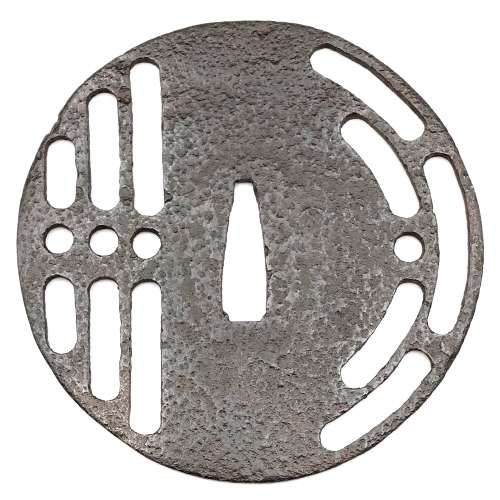 A very large and very thin iron tsuba of round form decorated with design of formalized butterfly and dragonfly in openwork (sukashi). The characteristics of the plate resemble those of Kamakura period ko-tōshō tsuba. However, the design seems too 'modern' to me, but it's hard to tell; it may be a late Muromachi or Momoyama period work. Tōshō or Ko-Tōshō school (or a Katchushi). Muromachi period. However, Boris Markhasin and Skip Holbrook insist this is a 20th-century machine-made tsuba. Dimensions: 99.6 x 100.5 x 2.1 mm. This is what Jim Gilbert says about old tsuba:
A very large and very thin iron tsuba of round form decorated with design of formalized butterfly and dragonfly in openwork (sukashi). The characteristics of the plate resemble those of Kamakura period ko-tōshō tsuba. However, the design seems too 'modern' to me, but it's hard to tell; it may be a late Muromachi or Momoyama period work. Tōshō or Ko-Tōshō school (or a Katchushi). Muromachi period. However, Boris Markhasin and Skip Holbrook insist this is a 20th-century machine-made tsuba. Dimensions: 99.6 x 100.5 x 2.1 mm. This is what Jim Gilbert says about old tsuba:"Traditionally the old iron plate tsuba are classified into Ko Tosho (old sword smith), and Ko Katchushi (old armor maker) styles. It is sometimes difficult to justify attribution of a given tsuba to the Tosho or Katchushi category. Generally guards with raised rims or relatively complex designs tend to be assigned to Katchushi. This is basically a convention we follow out of habit and convenience." [...] "In Token Kai-Shi part six, Articles by Akiyama Kyusaku, Robert Haynes comments: "…from 1300 to 1400 over 150,000 MOUNTED swords were made in Japan for export alone. This means that over four tsuba a day were made for 100 years. This would mean that at least 3000 persons were making nothing but tsuba, let alone all the other fittings needed to complete these swords. With sword smiths, fittings makers and all the other artists need to complete a sword for export, at least 10,000 sword artists were working together, in any one of these hundred years."
Another tsuba of similar design, Tōshō school, is illustrated in this collection; see TSU-0319.2015.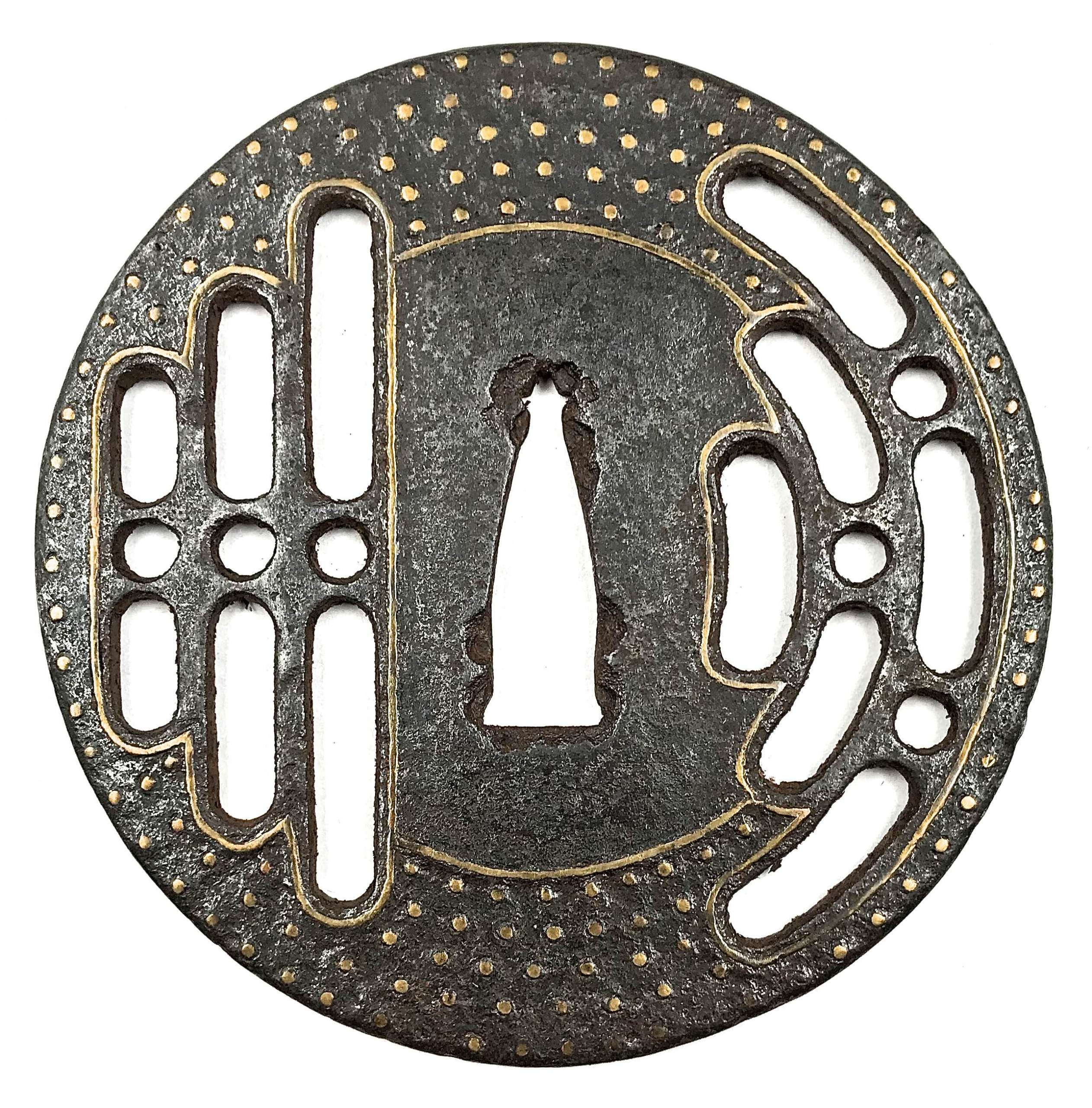 Reference to this design can be found in LIB-1359.2017 Japanese Swords and Tsuba from the Professor A. Z. Freeman and the Phyllis Sharpe Memorial collections, Sotheby's, London, Thursday 10 April 1997; p. 18-19, lot № 37: "A Kamakura-bori Tsuba, Momoyama Period. ...pierced with two large formalised butterflies..."
Reference to this design can be found in LIB-1359.2017 Japanese Swords and Tsuba from the Professor A. Z. Freeman and the Phyllis Sharpe Memorial collections, Sotheby's, London, Thursday 10 April 1997; p. 18-19, lot № 37: "A Kamakura-bori Tsuba, Momoyama Period. ...pierced with two large formalised butterflies..."

A Kamakura-bori tsuba of octagonal form, Momoyama period.
-
 Evening Snow on Mount Hira (Hira no bosetsu), from the series Eight Views of Ōmi in Modern Guise (Ryaku Ōmi hakkei, (略近江八景). About 1773–75 (An'ei 2–4). Artist: Isoda Koryūsai (Japanese, 1735–1790) CATALOGUE RAISONNÉ: Hockley 2003, p. 202, #F-21-1 DIMENSIONS: Vertical chûban; 26 x 19.3 cm (10 1/4 x 7 5/8 in.)Signed: Koryû ga [湖竜画]
Evening Snow on Mount Hira (Hira no bosetsu), from the series Eight Views of Ōmi in Modern Guise (Ryaku Ōmi hakkei, (略近江八景). About 1773–75 (An'ei 2–4). Artist: Isoda Koryūsai (Japanese, 1735–1790) CATALOGUE RAISONNÉ: Hockley 2003, p. 202, #F-21-1 DIMENSIONS: Vertical chûban; 26 x 19.3 cm (10 1/4 x 7 5/8 in.)Signed: Koryû ga [湖竜画] -
 Richard Parkes Bonington (1802–1828 ). British/French. Evreux: Tour du Gros Horloge (Evreux: Large Clock Tower). Inscription: The tower was built in 1417 when the area was ruled by England. Lithograph. From the Taylor and Nodier set "Normandie", Vol. II, pl. 226. 1824. MET# 22.87.2. Catalogue Raisonné: Curtis 1939, no. 19. MET description: "This view in the French town of Evreux focuses on the clock tower, with vendors and customers in the street below. Bonington produced the print for the multi-volume series directed by Baron Isidore Taylor, Charles Nodier and Alphonse de Cailleux titled "Voyages Pittoresques et Romantiques dans l'Ancienne France" (Picturesque and Romantic Travels through Historic France). This image appears in volume 2, devoted to Normandy."
Richard Parkes Bonington (1802–1828 ). British/French. Evreux: Tour du Gros Horloge (Evreux: Large Clock Tower). Inscription: The tower was built in 1417 when the area was ruled by England. Lithograph. From the Taylor and Nodier set "Normandie", Vol. II, pl. 226. 1824. MET# 22.87.2. Catalogue Raisonné: Curtis 1939, no. 19. MET description: "This view in the French town of Evreux focuses on the clock tower, with vendors and customers in the street below. Bonington produced the print for the multi-volume series directed by Baron Isidore Taylor, Charles Nodier and Alphonse de Cailleux titled "Voyages Pittoresques et Romantiques dans l'Ancienne France" (Picturesque and Romantic Travels through Historic France). This image appears in volume 2, devoted to Normandy." -
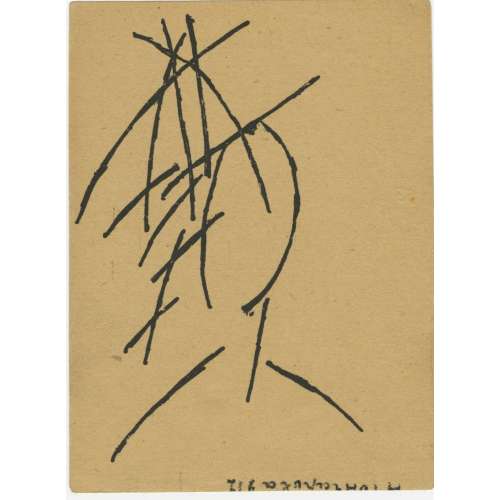 Artist: Mikhail Larionov (June 3, 1881 – May 10, 1964) ). Russian/French. Lithographic illustration "Woman in a hat" for Aleksei Kruchenykh book "Lipstick", Moscow, Kuzmin and Dolinsky Publishers, 1913, 480 copies printed. Size: 11,3 х 8,2 cm. Михаил Ларионов (3 июня 1881 – 10 мая 1964). Россия/Франция. Литографическая иллюстрация "Женщина в шляпе" к книге Алексея Крученых "Помада"; М.: Изд. Г.Л. Кузьмина и С.Д. Долинского, 1913, отпечатана в 480 экз. Формат: 11,3 х 8,2 см.
Artist: Mikhail Larionov (June 3, 1881 – May 10, 1964) ). Russian/French. Lithographic illustration "Woman in a hat" for Aleksei Kruchenykh book "Lipstick", Moscow, Kuzmin and Dolinsky Publishers, 1913, 480 copies printed. Size: 11,3 х 8,2 cm. Михаил Ларионов (3 июня 1881 – 10 мая 1964). Россия/Франция. Литографическая иллюстрация "Женщина в шляпе" к книге Алексея Крученых "Помада"; М.: Изд. Г.Л. Кузьмина и С.Д. Долинского, 1913, отпечатана в 480 экз. Формат: 11,3 х 8,2 см. -
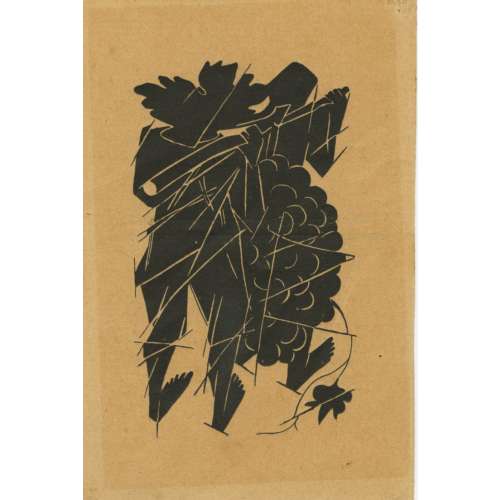 Artist: Natalia Goncharova (July 3, 1881 – October 17, 1962). Russian/French. Lithographic illustration (frontispiece) for Sergei Bobrov book of poetry "The gardeners upon the grapevines", Moscow, Lirika Publishers, 1913. Size: 18 х 11,5 cm.
Artist: Natalia Goncharova (July 3, 1881 – October 17, 1962). Russian/French. Lithographic illustration (frontispiece) for Sergei Bobrov book of poetry "The gardeners upon the grapevines", Moscow, Lirika Publishers, 1913. Size: 18 х 11,5 cm.Book was printed on May 20, 1913 for Lirika Publishers, by V. I. Voronov printshop in 500 copies, of them 50 authored and numbered. 10 lithographs by Natalia Goncharova printed at Kushneryov & Co. lithography in Moscow.
Наталия Гончарова (3 июля 1881 – 17 октября 1962). Россия/Франция. Литографическая иллюстрация (фронтиспис) к книге С. П. Боброва "Вертоградари над лозами" [Сергей Бобров. М.: /Лирика, 1913]. Формат: 18 х 11,5 см.Тираж 500 экз, из них 50 авторизованных и нумерованных. Десять цветных рисунков работы Н. Гончаровой исполнены в технике литографии на отдельных листах. Книга отпечатана 20 мая 1913 года в типографии В.И. Воронова для книгоиздательства «Лирика». В мягкой издательской обложке. На с. 162 после списка литографий: Отпечатаны литографией т-ва И.Н. Кушнерев и К° в Москве.
-
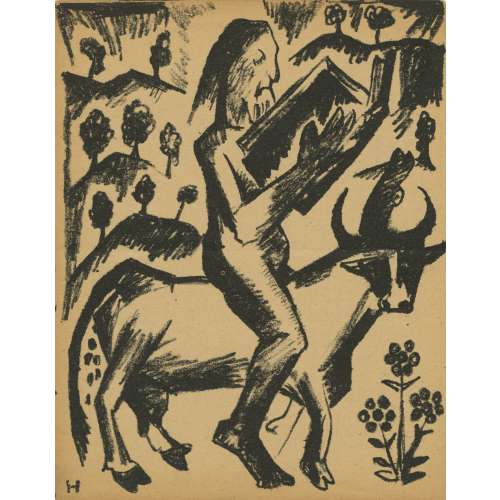 Artist: Natalia Goncharova (July 3, 1881 – October 17, 1962). Russian/French. Lithographic illustration "An elder astride a bull" for Aleksei Kruchenykh book "Two poems. The Hermit. The Hermitess", Moscow, Kuzmin and Dolinsky Publishers, 1913. This sheet is from the book "Natalia Goncharova / Mikhail Larionov" by Eli Eganbyuri (pen-name of Ilia Zdanevich), published by Z. A. Münster in 1913. Inscription on the back: hand-written copy (allegedly by the hand of Osip Brik) of Vladimir Mayakovsky verses for "Red Pepper" (Krasny peretz) magazine issue of 1924, included in the compilation "Ferocious laugh" (Grozny smekh) that was published after Mayakovsky death in 1931. Text of the manuscript on verso. Size: 18,5 х 14,3 cm. Наталия Гончарова (3 июля 1881 – 17 октября 1962). Россия/Франция. Автолитография "Старец верхом на быке" для книги А. Е. Крученых "Две поэмы. Пустынники. Пустынница"; - М.: Изд. Г.Л. Кузьмина, С.Д. Долинского, 1913. Данный лист из книги Эли Эганбюри (псевдоним Ильи Зданевича) "Наталия Гончарова / Михаил Ларионов"; - М. : Изд. Ц. Мюнстера, 1913. На обороте список стихов из подписей к "Красному перцу" 1924 г., которые вошли в сб. "Грозный смех" (вышел после смерти Маяковского в 1931). Вероятно список сделан рукой Осипа Брика. Текст манускрипта. Формат: 18,5 х 14,3 см.
Artist: Natalia Goncharova (July 3, 1881 – October 17, 1962). Russian/French. Lithographic illustration "An elder astride a bull" for Aleksei Kruchenykh book "Two poems. The Hermit. The Hermitess", Moscow, Kuzmin and Dolinsky Publishers, 1913. This sheet is from the book "Natalia Goncharova / Mikhail Larionov" by Eli Eganbyuri (pen-name of Ilia Zdanevich), published by Z. A. Münster in 1913. Inscription on the back: hand-written copy (allegedly by the hand of Osip Brik) of Vladimir Mayakovsky verses for "Red Pepper" (Krasny peretz) magazine issue of 1924, included in the compilation "Ferocious laugh" (Grozny smekh) that was published after Mayakovsky death in 1931. Text of the manuscript on verso. Size: 18,5 х 14,3 cm. Наталия Гончарова (3 июля 1881 – 17 октября 1962). Россия/Франция. Автолитография "Старец верхом на быке" для книги А. Е. Крученых "Две поэмы. Пустынники. Пустынница"; - М.: Изд. Г.Л. Кузьмина, С.Д. Долинского, 1913. Данный лист из книги Эли Эганбюри (псевдоним Ильи Зданевича) "Наталия Гончарова / Михаил Ларионов"; - М. : Изд. Ц. Мюнстера, 1913. На обороте список стихов из подписей к "Красному перцу" 1924 г., которые вошли в сб. "Грозный смех" (вышел после смерти Маяковского в 1931). Вероятно список сделан рукой Осипа Брика. Текст манускрипта. Формат: 18,5 х 14,3 см.Г. Л. Кузьмин и С. Д. Долинский знамениты, в частности, тем, что в 1912 году издали футуристский манифест "Пощечина общественному вкусу". О них можно найти дополнительную информацию в статье об Л. Л. Кузьмине. Издатель Цезарь Александрович Мюнстер был сыном знаменитого русского литографа Александра Эрнестовича Мюнстера, открывшего свое литографическое заведение в Санкт-Петербурге в 1850 году. Судьба Ц. А. Мюнстера и его издательства после революции 1917 года мне неизвестна.
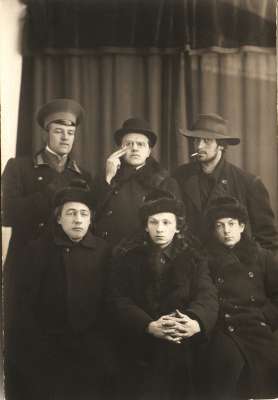
Сидят: В.В. Хлебников, Г.Л. Кузьмин, С.Д. Долинский Стоят: Н.Д. Бурлюк, Д.Д. Бурлюк, В.В. Маяковский. 1911.
-
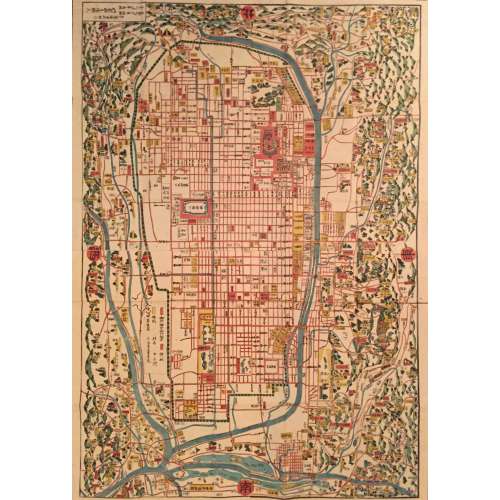
-
